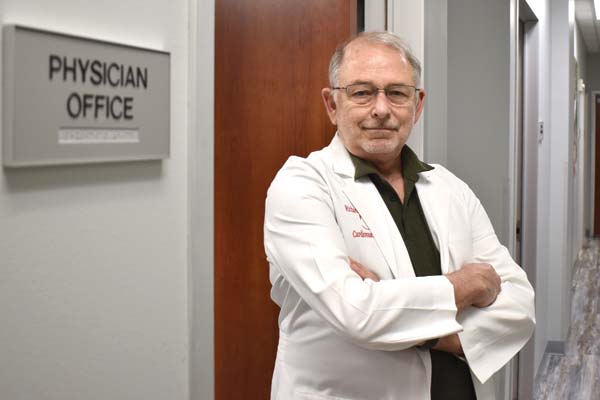After performing hundreds of heart valve replacements at Our Lady of Lourdes Regional Medical Center and Our Lady of Lourdes Heart Hospital, renowned local heart surgeon Richard Dearman, MD, recently underwent a heart valve replacement of his own.
As a cardiothoracic surgeon helping heart patients in Acadiana, Dr. Dearman participated in hundreds of heart procedures over his 30 years in service, never expecting that one day he would need one, himself.
New techniques and equipment developed over the years meant less invasive procedures to remedy conditions formerly corrected only through open-heart surgery. Still, Dr. Dearman was intrigued when Our Lady of Lourdes Health began to offer Transcatheter Aortic Valve Replacement (TAVR) nearly a decade ago.
“The first aortic valve operation that took place in the early 1960s is pretty much the same operation we do now. It works great and gives people a whole new way of living, but it is obviously a big procedure,” he said. “When I see a procedure like TAVR that lowers the invasiveness and makes it easier for patients to recover, that is clearly in the patient’s best interest.”
Initially, most patients who qualified for a heart valve replacement through TAVR likely would not have survived traditional open-heart surgery, Dr. Dearman said, or they would have had a higher likelihood of complications. “I’ve seen nothing in my career that equals this kind of technological advancement. I truly consider it on the order of a medical miracle,” he said.
The Doctor Becomes the Patient
In regard to his own heart health journey, Dr. Dearman recently began to feel more fatigued than normal and noticed other symptoms. So, he went to his cardiologist, Eric Thomassee, MD, and discovered his heart valve needed to be replaced. In December, Dr. Dearman became the 500th patient to undergo a TAVR procedure at Our Lady of Lourdes Heart Hospital. The next day, Dr. Dearman was home and the next week back working in the operating room.
“I felt honored that Dr. Dearman, who I look up to as a cardiothoracic surgeon, professional, and friend, asked me to perform the procedure,” Dr. Thomassee said. “His procedure and recovery were in line with established expectations for the TAVR procedure. He was back on his feet helping to change and save lives in relatively little time.”
For a TAVR procedure, a valve is placed on a balloon and inserted through an artery in the patient’s groin. Once the balloon is in the correct position, the surgeon inflates it and implants the new valve. Most patients go home the next day, Dr. Dearman noted, unlike traditional aortic valve surgeries that usually require a four- to 10-day hospital stay. After TAVR, patients typically must limit their activities for about 10 days before gradually returning to a normal lifestyle.
“This is not God’s valve. They typically last 8 to 12 years,” Dr. Dearman explained. “Still, this is one of the most incredible medical advances for patients. It’s not going to replace surgery, but it will keep a lot of people from having a more invasive procedure. It adds years and quality to lives that may otherwise be cut short.”
For a TAVR to be successful, Dr. Dearman said the patient must undergo several cardiac tests before the procedure to determine if he or she is a good candidate. Doctors also evaluate the patient’s entire medical history and other conditions before moving forward.
“All of that information helps us determine whether this is best for the patient,” he said. “We want to make sure that we are doing something that is beneficial for them and that will not cause negative effects.”
From Serving the Country to Serving Patients
Dr. Dearman began practicing in Lafayette in 1994 following a distinguished military career. He served 16 years in the U.S. Army Reserve Medical Corps, achieving the rank of Lieutenant Colonel. He also received Meritorious Service Medals in 1985 and 1988. During Operation Desert Storm, Dr. Dearman was on the first team to receive and treat wounded soldiers from the battlefield.
In addition to providing him with opportunities to serve his country and advance his medical studies, Dr. Dearman’s military service also brought him in close proximity with some of the world’s most prominent dignitaries. In 1984, he was stationed in Fairbanks, Alaska as a general surgeon when then-President Ronald Reagan and Pope John Paul II chose to have a meeting in the city. Dr. Dearman was a physician on standby in case either man or their associates needed medical attention.
“I was not really near them, but I was in the hospital for about 36 hours and standing shoulder-to-shoulder with the Secret Service,” Dr. Dearman recalled. “You don’t realize how many details go into those visits until you are involved. It was eye-opening and very educational. The Secret Service guys are incredible. They are just like us and can have a good conversation, but they become completely different when their game faces go on and it’s time to work.”




